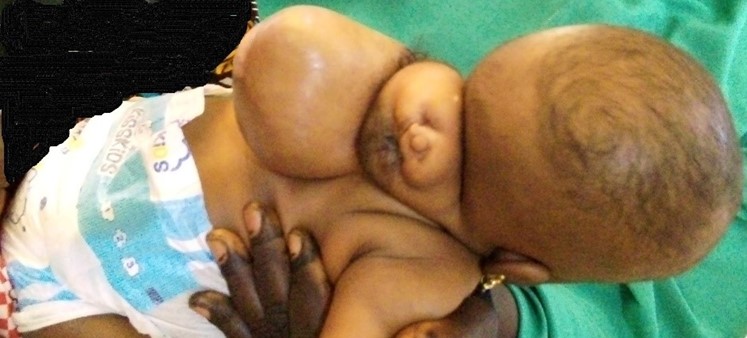Parasitic Craniopagus with Cervical Myelomeningocele and Hydrocephalus: Reporting the rarely Reported
DOI:
https://doi.org/10.46900/apn.v5i3.194Keywords:
parasitic twin, craniopagus, hydrocephalus, myelomeningoceleAbstract
Objective: parasitic craniopagus is an extremely rare neurosurgical condition globally, additional anomalies such as hydrocephalus and myelomeningocele make it even more uncommon and complex to manage. The objective of this report was to describe successful management of a child with triad of craniopagus parasiticus, congenital hydrocephalus and cervical myelomeningocele
Case presentation: we successfully managed a five-month-old female infant with parasitic craniopagus, cervical myelomeningocele and congenital hydrocephalus.
Conclusion: parasitic craniopagus remains an uncommon neurosurgical condition and can be associated with many congenital anomalies such as hydrocephalus and myelomeningocele, careful evaluation and management will confer favourable outcome.
Objective: parasitic craniopagus is an extremely rare neurosurgical condition globally, additional anomalies such as hydrocephalus and myelomeningocele make it even more uncommon and complex to manage. The objective of this report was to describe successful management of a child with triad of craniopagus parasiticus, congenital hydrocephalus and cervical myelomeningocele
Case presentation: we successfully managed a five-month-old female infant with parasitic craniopagus, cervical myelomeningocele and congenital hydrocephalus.
Conclusion: parasitic craniopagus remains an uncommon neurosurgical condition and can be associated with many congenital anomalies such as hydrocephalus and myelomeningocele, careful evaluation and management will confer favourable outcome.
Downloads

Additional Files
Published
How to Cite
Issue
Section
Categories
License
Copyright (c) 2023 Aliyu Muhammad Koko, Ali Lasseini, Nasiru Jinjiri Isma, Bello Bala Shehu

This work is licensed under a Creative Commons Attribution 4.0 International License.

When publishing in Archives of Pediatric Neurosurgery journal, authors retain the copyright of their article and agree to license their work using a Creative Commons Attribution 4.0 International Public License (CC BY 4.0), thereby accepting the terms and conditions of this license (https://creativecommons.org/licenses/by/4.0/legalcode).
The CC BY 4.0 license terms applies to both readers and the publisher and allows them to: share (copy and redistribute in any medium or format) and adapt (remix, transform, and build upon) the article for any purpose, even commercially, provided that appropriate credit is given to the authors and the journal in which the article was published.
Authors grant Archives of Pediatric Neurosurgery the right to first publish the article and identify itself as the original publisher. Under the terms of the CC BY 4.0 license, authors allow the journal to distribute the article in third party databases, as long as its original authors and citation details are identified.





























